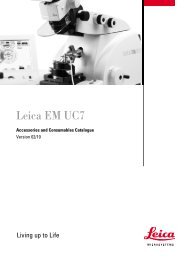Physical Principles of Electron Microscopy: An Introduction to TEM ...
Physical Principles of Electron Microscopy: An Introduction to TEM ...
Physical Principles of Electron Microscopy: An Introduction to TEM ...
You also want an ePaper? Increase the reach of your titles
YUMPU automatically turns print PDFs into web optimized ePapers that Google loves.
60 Chapter 3<br />
The rate <strong>of</strong> electron emission can be represented as a current density Je<br />
(in A/m 2 ) at the cathode surface, which is given by the Richardson law:<br />
Je = A T 2 exp(� �/kT) (3.1)<br />
In Eq. (3.1), T is the absolute temperature (in K) <strong>of</strong> the cathode and A is the<br />
Richardson constant (� 10 6 Am -2 K -2 ), which depends <strong>to</strong> some degree on the<br />
cathode material but not on its temperature; k is the Boltzmann constant<br />
(1.38 � 10 -23 J/K), and kT is approximately the mean thermal energy <strong>of</strong> an<br />
a<strong>to</strong>m (or <strong>of</strong> a conduction electron, if measured relative <strong>to</strong> the Fermi level).<br />
The work function � is conveniently expressed in electron volts (eV) <strong>of</strong><br />
energy and must be converted <strong>to</strong> Joules by multiplying by e =1.6 � 10 -19 for<br />
use in Eq. (3.1). Despite the T 2 fac<strong>to</strong>r, the main temperature dependence in<br />
this equation comes from the exponential function. As T is increased, Je<br />
remains very low until kT approaches a few percent <strong>of</strong> the work function.<br />
The temperature is highest at the tip <strong>of</strong> the V-shaped filament (farthest from<br />
the leads, which act as heat sinks), so most <strong>of</strong> the emission occurs in the<br />
immediate vicinity <strong>of</strong> the tip.<br />
Tungsten has a high cohesive energy and therefore a high melting point<br />
(� 3650 K) and also a low vapor pressure, allowing it <strong>to</strong> be maintained at a<br />
temperature <strong>of</strong> 2500 � 3000 K in vacuum. Despite its rather high work<br />
function (� = 4.5 eV), �/kT can be sufficiently low <strong>to</strong> provide adequate<br />
electron emission. Being an electrically conducting metal, tungsten can be<br />
made in<strong>to</strong> a thin wire that can be heated by passing a current through it. In<br />
addition, tungsten is chemically stable at high temperatures: it does not<br />
combine with the residual gases that are present in the relatively poor<br />
vacuum (pressure > 10 -3 Pa) sometimes found in a thermionic electron gun.<br />
Chemical reaction would lead <strong>to</strong> contamination (“poisoning”) <strong>of</strong> the<br />
emission surface, causing a change in work function and emission current.<br />
<strong>An</strong> alternative strategy is <strong>to</strong> employ a material with a low work function,<br />
which does not need <strong>to</strong> be heated <strong>to</strong> such a high temperature. The preferred<br />
material is lanthanum hexaboride (LaB6; � = 2.7 eV), fabricated in the form<br />
<strong>of</strong> a short rod (about 2 mm long and less than 1 mm in diameter) sharpened<br />
<strong>to</strong> a tip, from which the electrons are emitted. The LaB6 crystal is heated (<strong>to</strong><br />
1400 � 2000 K) by mounting it between wires or on<strong>to</strong> a carbon strip through<br />
which a current is passed. These conducting leads are mounted on pins set<br />
in<strong>to</strong> an insulating base whose geometry is identical with that used for a<br />
tungsten-filament source, so that the two types <strong>of</strong> electron source are<br />
mechanically interchangeable. Unfortunately, lanthanum hexaboride<br />
becomes poisoned if it combines with traces <strong>of</strong> oxygen, so a better vacuum<br />
(pressure < 10 -4 Pa) is required in the electron gun. Oxide cathode materials



